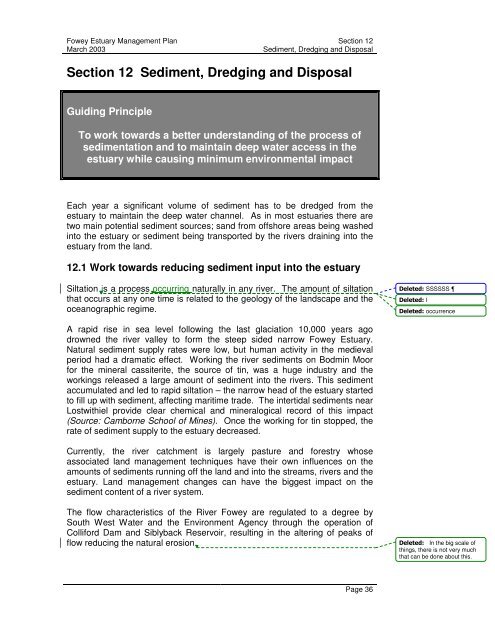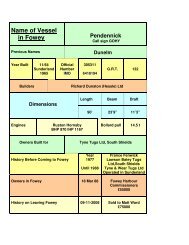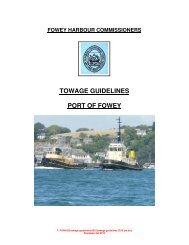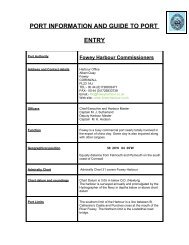Fowey Estuary Management Plan Fowey Estuary ... - Fowey Harbour
Fowey Estuary Management Plan Fowey Estuary ... - Fowey Harbour
Fowey Estuary Management Plan Fowey Estuary ... - Fowey Harbour
You also want an ePaper? Increase the reach of your titles
YUMPU automatically turns print PDFs into web optimized ePapers that Google loves.
<strong>Fowey</strong> <strong>Estuary</strong> <strong>Management</strong> <strong>Plan</strong> Section 12<br />
March 2003 Sediment, Dredging and Disposal<br />
Section 12 Sediment, Dredging and Disposal<br />
Guiding Principle<br />
To work towards a better understanding of the process of<br />
sedimentation and to maintain deep water access in the<br />
estuary while causing minimum environmental impact<br />
Each year a significant volume of sediment has to be dredged from the<br />
estuary to maintain the deep water channel. As in most estuaries there are<br />
two main potential sediment sources; sand from offshore areas being washed<br />
into the estuary or sediment being transported by the rivers draining into the<br />
estuary from the land.<br />
12.1 Work towards reducing sediment input into the estuary<br />
Siltation is a process occurring naturally in any river. The amount of siltation<br />
that occurs at any one time is related to the geology of the landscape and the<br />
oceanographic regime.<br />
A rapid rise in sea level following the last glaciation 10,000 years ago<br />
drowned the river valley to form the steep sided narrow <strong>Fowey</strong> <strong>Estuary</strong>.<br />
Natural sediment supply rates were low, but human activity in the medieval<br />
period had a dramatic effect. Working the river sediments on Bodmin Moor<br />
for the mineral cassiterite, the source of tin, was a huge industry and the<br />
workings released a large amount of sediment into the rivers. This sediment<br />
accumulated and led to rapid siltation – the narrow head of the estuary started<br />
to fill up with sediment, affecting maritime trade. The intertidal sediments near<br />
Lostwithiel provide clear chemical and mineralogical record of this impact<br />
(Source: Camborne School of Mines). Once the working for tin stopped, the<br />
rate of sediment supply to the estuary decreased.<br />
Currently, the river catchment is largely pasture and forestry whose<br />
associated land management techniques have their own influences on the<br />
amounts of sediments running off the land and into the streams, rivers and the<br />
estuary. Land management changes can have the biggest impact on the<br />
sediment content of a river system.<br />
The flow characteristics of the River <strong>Fowey</strong> are regulated to a degree by<br />
South West Water and the Environment Agency through the operation of<br />
Colliford Dam and Siblyback Reservoir, resulting in the altering of peaks of<br />
flow reducing the natural erosion.<br />
Page 36<br />
Deleted: SSSSSS <br />
Deleted: I<br />
Deleted: occurrence<br />
Deleted: In the big scale of<br />
things, there is not very much<br />
that can be done about this.










